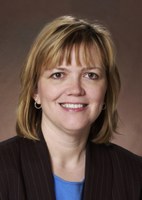Prairie Fare: Take a Step Back in Baking History
(Click the image below to view a high-resolution image that can be downloaded)
By Julie Garden-Robinson, Food and Nutrition Specialist
NDSU Extension Service
“Add butter the size of an egg,” the recipe said.
“To measure oven temperature, insert your hand well into the oven and count the number of seconds you can hold it there,” another recipe advised.
I was reading a Civil War-era cookbook that I bought at a museum on my recent vacation.
Of course, they didn’t have sticks of butter with the tablespoons delineated on the wrapper in those days. They regulated oven temperature by the amount of wood they added to the stove, not by turning a dial or punching in a digital code.
I decided I would have burned a lot of bread and cakes had I lived 150 years ago.
I also perused the household hints section. They made their own “tooth wash” with Borax and camphor. They made homemade soap with lye and grease.
If you lost some hair during an illness, according to the book, you could restore it with black tea and your best brandy. You were supposed to rub the concoction on your head, however, not drink it.
The cookbook also had a recipe for an ointment to make in case you had an unfortunate gunpowder burn.
Life in the mid- to late-1800s was sounding more difficult with every page I turned.
Times certainly have changed, but some of the recipes are quite similar to modern-day recipes. Baking in earlier times was probably more art than science. Sometimes they needed to skip expensive or unavailable ingredients, even eggs.
As we know from food science and product development research, careful measuring helps recreate recipes later, provides for consistent reactions of the ingredients with each other and ensures consistent nutritional content of the recipe.
Careful measuring also prevents “flops,” which are those unfortunate events when a prized cake recipe looks more like a pancake when it is pulled from the oven.
Perhaps you learned about measuring in school or from a relative. Maybe that’s awhile ago now. Let’s review some measuring basics.
Dry and liquid ingredients are measured differently. For more accurate measurements, dry ingredients commonly are measured in nesting measuring cups.
Liquid ingredients should be measured in clear cups with a measurement spout and measurement lines. When measuring liquid ingredients, such as oil or water, bend down to eye level to check the measurement. Add or remove as much as needed until the top of the liquid is at the desired mark.
Some ingredients need special consideration. Follow this advice unless the recipe has other recommendations:
- Brown sugar: pack into the measuring spoon before it is leveled off.
- Flour: spoon into the measuring cup and then level off. If you dip the measuring cup into the flour bag, you could end up with 25 percent more flour than you actually need.
- Butter or margarine: use the measurements on the wrapper. One stick of butter or margarine equals one-half cup or 8 tablespoons.
Practice your measuring skills with this quick and easy recipe that features a seasonal favorite - peaches. It’s from the Pennsylvania Nutrition Education Program.
Peach Crisp
4 c. sliced peaches (about four peaches)
2 Tbsp. margarine or butter
3/4 c. quick-cooking oats
1/2 c. sugar
1/4 c. flour
2 tsp. cinnamon
1 tsp. lemon juice
Preheat the oven to 375 degrees. Peel and slice the peaches. Spread the peach slices on the bottom of a baking pan (about 8 inches by 8 inches). Melt the butter or margarine in a saucepan. Mix the oatmeal, sugar, flour, cinnamon and lemon juice in a bowl. Sprinkle the oat mixture on top of the peaches. Bake for 20 minutes. Serve it hot or cold. Top with a dollop of whipped cream.
Makes six servings. Each serving has 200 calories, 4.5 grams (g) of fat, 40 g of carbohydrate and 3 g of fiber.
(Julie Garden-Robinson, Ph.D., L.R.D., is a North Dakota State University Extension Service food and nutrition specialist and associate professor in the Department of Health, Nutrition and Exercise Sciences.)
NDSU Agriculture Communication
| Source: | Julie Garden-Robinson, (701) 231-7187, julie.garden-robinson@ndsu.edu |
|---|---|
| Editor: | Rich Mattern, (701) 231-6136, richard.mattern@ndsu.edu |


